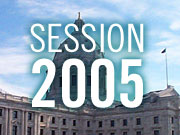March 1, 2005
 |
| Minnesota added a lot more jobs than previously estimated. Instead of creating 23,400 jobs last year, it turns out the Minnesota economy added more than 38,000 jobs -- an improvement of 64 percent. (MPR file photo/Jeff Horwich) |
St. Paul, Minn. — What a difference a day makes. On Tuesday, state economist Tom Stinson was announcing a state revenue forecast which presumes strong economic growth and 44,000 new jobs in 2005. But Stinson, a University of Minnesota professor and non-political appointee, expressed concern that state job growth last year had been weak and even declined at times.
"The question is: how do you explain what we've observed here, this decline? And that's a puzzle to us," Stinson said.
Just a day later, those jobs numbers Stinson had been working from shifted. It doesn't solve the puzzle, but it does change the picture. Minnesota added a lot more jobs than previously estimated. Instead of creating 23,400 jobs last year, it turns out the Minnesota economy added more than 38,000 jobs -- an improvement of 64 percent.
The difference comes from the way data were collected. The initial estimates are based on business surveys done month to month. Some time later, the state gets the actual numbers for how many jobs companies added. These revisions happen every year; this time, the difference was significant.
"I think we are showing a great deal more momentum," says economist Steve Hine, the top labor analyst for the state Department of Employment and Economic Development. "We've built up a greater head of steam heading into 2005 than we had previously thought, which does bode well, I think, for the outlook. I think this report generally does provide reason to be more optimistic about job growth in the coming year," he said.
The revised numbers stretch back to 2003. Instead of gaining 5,000 jobs that year as originally thought, it turns out the state actually lost that many. Last year though, job gains were much stronger, especially in the first part of the year. Overall job growth in 2004 was 1.3 percent. That still trailed the national rate, but to Hine the difference is negligible.
"There's still this disturbing pattern of no real increase in employment in the latter half of the year," Stinson notes.
He says the revelation of more jobs in 2004 doesn't do much to bolster his confidence. He says the new numbers can't cover up the fact that job growth in the back half of 2004 was "treading water."
"That's not the kind of growth that we need to have in this state's economy and that's not the kind of growth that we've had in the past," he said.
Despite the improvement in last year's numbers Stinson prefers to focus on something more current: the jobs estimates for January. Stinson says he was hoping to see up to 3,000 new jobs in January. Instead the state lost 5,600.
"We still need to add 11,000 jobs a quarter to meet our forecast for employment growth in minnesota. These January numbers just made that task a little harder," according to Stinson.
Some DFLers in the state Legislature say those numbers make the forecast downright unrealistic. It's a fairly critical point of argument, considering the jobs forecast is a critical factor determining state revenues.
But Stinson is sticking with the forecast. He says many other indicators in the economy, aside from jobs, point toward strong growth ahead: Worker productivity is settling into a lower range that will prod new job creation. The state's manufacturing sector grew 1.8 percent last year, many times faster than the national rate. State tax withholding collections are rising. And Stinson says claims for unemployment benefits are finally falling, a sign that the pace of layoffs is slowing.
"Those really turned the corner in January and early February and are moving in a really positive direction."
Stinson says such encouraging signs keep him convinced the state will gain the 44,000 envisioned in the budget forecast. If the prediction is borne out, it would put a strong dent -- but still just a dent -- in Minnesota's unemployment rolls. At latest count, 130,000 Minnesotans were looking for work -- twice as many as the typical number during the 1990s.





